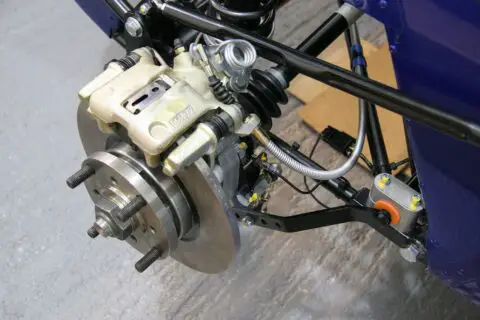Generally, driving a vehicle with a bad wheel speed sensor or ABS sensor is unsafe. Typically, a car has four ABS sensors, and now you’re wondering how to tell which ABS sensor is bad.
These sensors are the main part of your car’s Anti-lock Brake System (ABS). They communicate with each other to decide if one of the wheels is skidding and needs extra brake power.

But what happens when one ABS sensor is bad, and others are fine? In this article, we’ll teach you two easy DIY methods to find out which wheel ABS sensor is bad.
How To Tell Which ABS Sensor Is Bad
The easiest way to tell which ABS sensor is bad is using a car diagnostic scan tool. Just plug in the device, choose the car model and select diagnose ABS and it will show fault codes describing which speed sensor failed.
Alternatively, you can also use a multimeter or a voltmeter, but you will need to locate your ABS sensor and disconnect its wires.
Car Diagnostic Scan Tool
To test various car sensors, in this case, the wheel ABS sensors, you will need a car diagnostic scan tool. We highly recommend the Autel MaxiCOM MK808BT. The upgraded or 2021 version of the MK808 and MX808 features all systems diagnosis & 25+ Services (ABS Bleed, Oil Reset, EPB, SAS, DPF, BMS, Throttle, Injector Coding).
Here’s a video on how to use the MaxiCOM MK808:
Steps
Step 1: Connect Autel MaxiCOM MK808BT or any other auto diagnosis tool to your car. (Make sure the tool supports ABS scanning)
Step 2: Press the Diagnostics on the main screen, then choose the car model. Then select System Selection and let the device establish vehicle communication.
Step 3: Choose the geographical area (i.e., the USA) and wait for the diagnostic system to initialize
Step 4: Next, press the Control unit, select ABS VSA, and wait for the system data to load
Step 5: Press Read Codes; the tool will show you the fault codes.
In the example video, the tool was able to show the Diagnostic Trouble Codes (DTCs) C0037:14
The C0037 code means The Anti-Lock Brake System (ABS) Module monitors the Left Rear Wheel Speed Sensor. Specifically, C0037:14 means there is a short to ground or an open in the sensor signal return circuit or if the sensor has an internal short to ground or an internal open.
The fault code also triggers many other faults (i.e., steering angle sensor, left rear electric parking brake actuator, etc.)
Step 6: Fix or replace the faulty ABS sensor to get rid of all the fault codes and the warning lights on your dashboard.
Alternatively, you can also use an OBD2 scanner to scan the code. Some scan tools can read ABS/SRS trouble codes, but not all of them do. Check out which diagnostic tools are available and whether they suit your needs.
We highly recommend the FOXWELL NT630 Plus. The OBD scan tool allows temporary access to your ABS/airbag systems and components, including switches, sensors, relays& actuators.
Multimeter or Voltmeter
If you don’t have access to a scan tool, you can do a simple multimeter test to check for voltage on wheel ABS sensors. This method may require a car lift or a pair of ramps, so basic car repair skill is required. You will need to be able to remove the wheel to test ABS sensors.
We recommend using the KAIWEETS Digital Multimeter from Amazon. This advanced tester can diagnose automotive electrical issues including ABS sensors.
Steps
Step 1: Park the car on level ground, and turn the engine off. Hit the emergency brake.
Step 2: Locate your vehicle’s main fuse block and make sure that the ABS fuse filament remains intact. Replace the fuse if it is blown.
Step 3: Take a tire iron and loosen the lugs of the wheels. Then jack up the car and support it on a pair of good quality jack stands. Completely remove lug nuts with the tire iron and set them aside.
Step 4: Check beneath the brake disc and wires of the wheel speed sensor. The sensor is mounted on the rotor. Disconnect the wire by pulling it apart with your fingers. Inspect the two-pin connector.
Step 5: Clamp the voltmeter probes to the connection on the ABS sensor. Turn the voltmeter and set it to alternating current (AC). Make sure the probes aren’t touching to get an accurate reading.
Step 6: The voltmeter should read zero when it is turned on. Once the system reads this, you are ready to test.
Step 7: To test the ABS sensor, you need to spin the wheel hub with your hand. You should rotate it slowly. The spinning hub will create a charge that the voltmeter can measure. If the sensor is working, it should give a reading of around 400 volts. The reading will depend on how fast you spin the hub and varies depending on the car.
Step 8: When you get a correct reading on the first sensor, move on to the next.
Tips to get an accurate reading:
-check behind the wheel for a gear with teeth called an ABS reluctor
-make sure all the teeth are there and not damaged
-clear any metal shavings from this and then test the ABS sensor again
Conclusion
Finding which ABS Sensor can be done easily using a car diagnostic tool. But if no diagnostic tool is available to you, then the easiest way is by using a multimeter. In this tutorial, we have shown the steps to tell which ABS sensor is bad.
To avoid costly diagnostic from repair shops, invest in a car scanner (Autel MaxiCOM MK808BT) or a multimeter and learn how to use it. Aside from ABS, you can also use them to diagnose other car problems, like finding which O2 sensor is bad.


